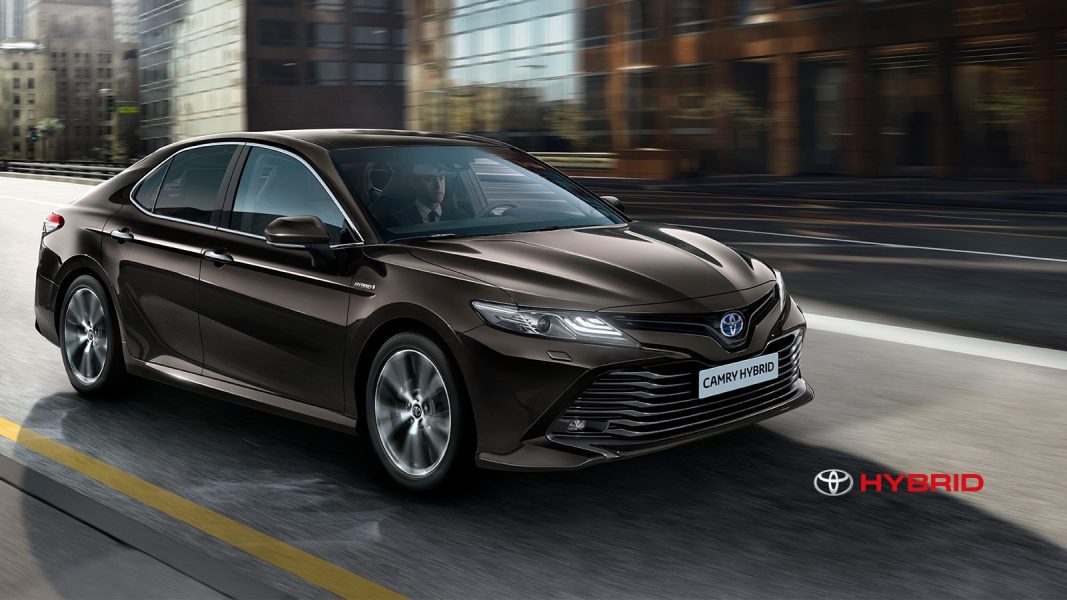
How Toyota Hybrid (HSD) works
Content
Everyone is well aware that Toyota's HSD hybridization has a reputation for being a workshop. The device of the Japanese brand (Aisin collaboration) is known not only for its efficiency, but also for its very good reliability. However, it is difficult to understand because of its complexity and the many possible modes of operation.

Therefore, we will try to understand how Toyota's hybrid device, the famous Serial / Parallel HSD e-CVT, works. The latter allows you to ride 100% electric or a combination of electric and thermal. Here I take on a somewhat complex topic, and sometimes I need to simplify it a little (although this does not detract from the logic and principle).
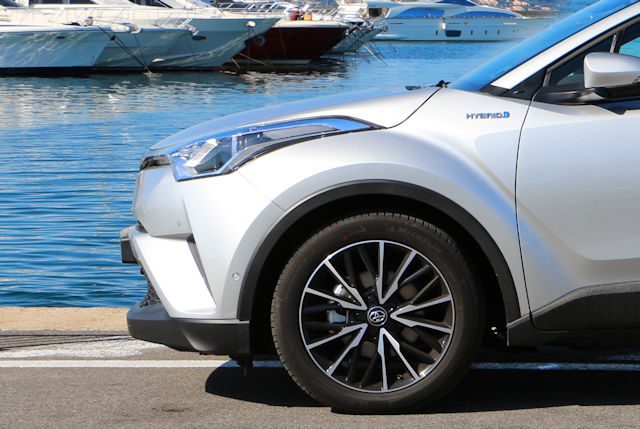
Now know that HSD transmissions are manufactured by Aisin (AWFHT15), of which Toyota owns 30%, and that they supply hybrid and non-hybrid transmissions to the PSA group when it comes to EAT or e-AT8. boxes. (hybrid2 and hybrid4). We are now in the fourth generation in terms of technical development. While the overall principle remains the same, small improvements are made to the center planetary gear or the layout to achieve compactness and efficiency (for example, shorter cable lengths reduce electrical losses).
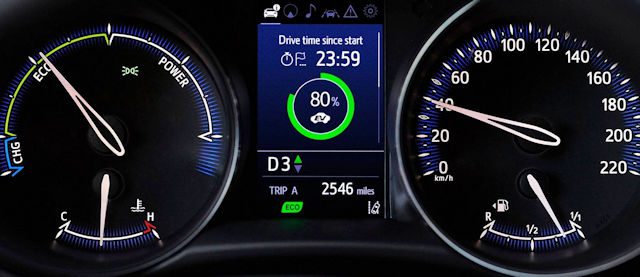
Synthetic explanation
If you want a holistic view of how HSD works, here's an explanation that sums it up. You need to go further in the article to delve deeper or try to understand what is eluding you at this stage.
Here are the roles of each component as well as the technical specifications of the HSD:
- The ICE (Internal Combustion Engine) is a heat engine: all energy comes from it, and therefore it is the basis of everything. It is connected to MG1 via an epicyclic train.
- MG1 serves as an electric generator (driven by a heat engine) as well as a gearbox variator. It connects ICE to MG2 via planetary gear (planetary). MG2 is connected directly to the wheels, so if the wheels turn, it turns, and if it turns the wheels too (in short, no disengagement is possible between them) ...
- MG2 serves as a traction motor (maximum distance 2 km or 50 km on plug-in / rechargeable) and also as an electric generator (deceleration: regeneration)
- Planetary Gear: It links MG1, MG2, ICE and the wheels together (this does not interfere with some of the elements being secured while others are spinning, you need to learn and understand how the planetary gear comes to life). Also thanks to him, we have a continuous change / decrease, and therefore it is he who represents the gearbox (the gear ratio changes, causing it to brake or "reverse": the link between ICE and MG1)
The reduction consists in more or less addition of the movements of the internal combustion engine (thermal) and MG2 (which is rigidly connected to the wheels, let's not forget).
Hybrid Planetary Gear Trainer
This video is perfect for getting a feel for how Toyota hybridization works.
New: Manual Sequential Mode on Toyota HSD Hybrid?
The engineers managed to simulate (partially ..) the reports by playing on how the MG1 would brake or reverse in a non-progressive manner to get clearer reports. The gear ratio is generated by MG1, which more or less firmly and more or less "slips" connects ICE and MG2 (MG2 = electric traction motor, but also, above all, wheels). Therefore, this decrease can be gradual or “staggered” depending on how the power distributor MG1 controls.
Note, however, that gear changes are not felt at partial load ... And at full load (maximum acceleration) we go back to continuously variable because this is the only way to get the best acceleration performance with this system (the computer therefore refuses to shift gears for maximum acceleration).
Therefore, this mode is used more for downhill engine braking than for sporty driving.
Corolla Hybrid 2.0 0-100 and Top Speed
This is what it actually looks like. Unfortunately, at full load, we lose sequential mode and we no longer feel the gears.
Multiple versions?
Apart from the different generations, the THS / HSD / MSHS system as applied to Toyota and Lexus has two main variants. The first and most common is the transverse version, which today is embodied in the Aisin AWFHT15 (in the early 90s it was called THS for the Toyota Hybrid System. Now it is HSD for the Hybrid Synergy Drive). It comes in two more or less compact models: Prius / NX / C-HR (larger), corolla and Yaris (small).
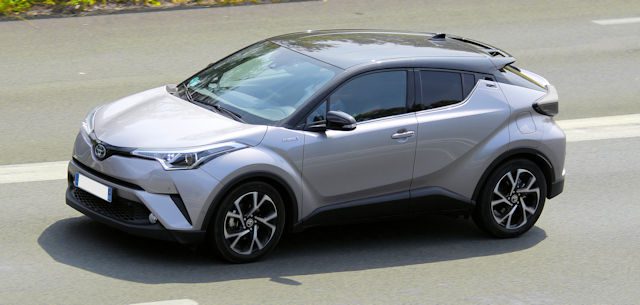

Here is a more modern (Prius 4) HSD transmission from transverse versions (now there are two different sizes, here is the larger one). It is much more compact than the variant you can see below (not the one just below the longitudinal one, even below...)
Toyota Prius IV 2016 1.8 Hybrid Acceleration 0-180 km / h
Prius 4 at full throttle, here is the famous continuous change effect produced by the combination of electric motors / generators, a heat engine and a central planetary train.
Then comes the MSHS for the multi-stage hybrid system (which I don't really have to talk about here ... But since it works identically, it also comes from Aisin and is designed for the Toyota group ...) that's very important. a larger device that must be positioned longitudinally and which can this time generate real gears, of which there are 10 (4 real gears in a box and a combination of electric motors in a clever way to achieve 10.Total therefore, not a multiple of 4, but this does not matter).
There are actually two versions: AWRHT25 and AWRHM50 (MSHS, which has 10 reports).
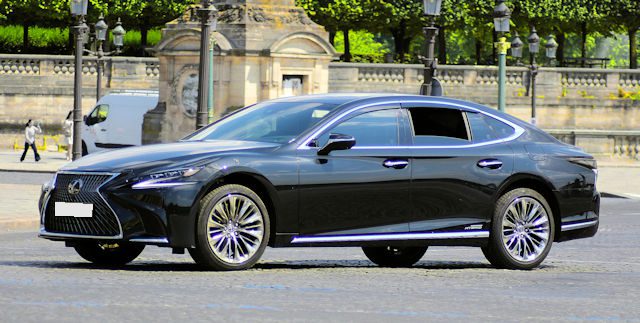
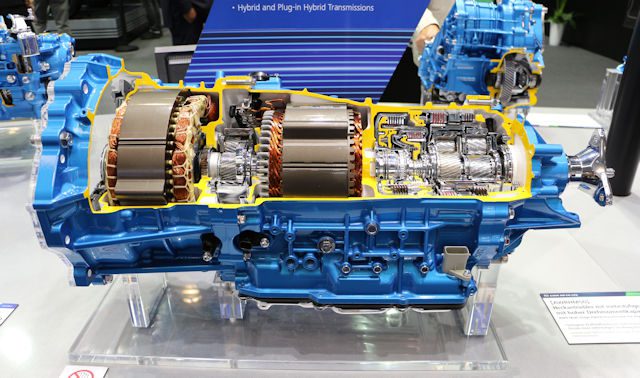
The much more prestigious longitudinal version (here AWRHM50) is intended primarily for Lexus (few Toyota have an engine in that sense). There are two versions, one of which can generate up to 10 real reports.
2016 Lexus IS300h 0-100km / h and driving modes (eco, normal, sport)
Go back to 1:00 minute to see how AWFHT15 can generate reports. Oddly enough, the famous "jumps in speed" are no longer felt when the engine is fully loaded ... This is because the device is most efficient (chronograph) in variator mode, so full load induces a normal continuous variation mode.
How does a Toyota hybrid work?
So what is the basic principle of the HSD hybrid device? If we had to summarize this roughly, we could talk about a heat engine that operates with two motors / generators (the electric motor is always reversible) and whose different torques (of each engine) are controlled and controlled by the central planetary train, but also the electrical intensity (and direction of electricity) controlled by a power distributor ("inverter" in English). The reduction gear (CVT gearbox) is electronically controlled, causing the MG1 engine to operate in a specific way, as well as through a central planetary gear, which allows multiple powers to be combined to output one.
The engine can be completely decoupled from the wheels, as well as through the planetary drive ...
In short, even if we want to simplify, we understand that it will not be so easy to assimilate, so we will focus on the basic principles. However, I have put you a video in English detailing the details, so if you want to push it through, you should be able to do it (with motivation and healthy neurons, of course).

Here is the Prius 2, which is less compact than the one I showed you above. See how they highlighted the A / C compressor (blue to the left of the engine). Indeed, unlike any "normal" machine, it is driven by an electric motor. The wheels are connected to a chain that can be seen in the center section on the right (right in the middle of the electronic variator).
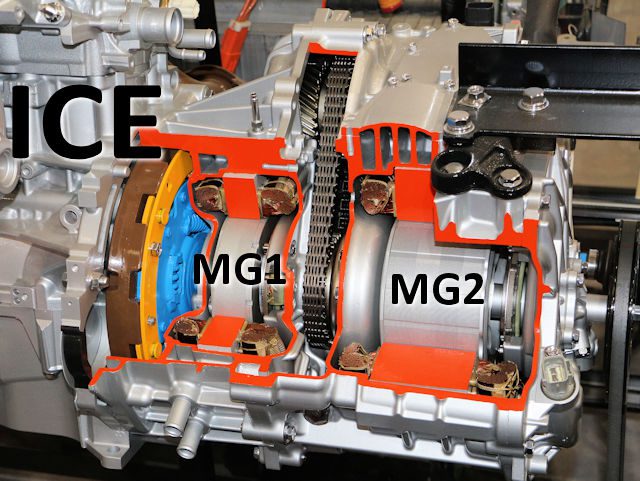
electronic variator near

In profile, we see one of the wheel suspensions connected to the chain via a differential.
Various operating modes
Let's take a look at the different modes of operation of a device and, along the way, why it is considered serial/parallel, while usually a hybrid system is either one or the other. The ingenious way HSD is designed allows for both, and that also makes it a little tricky...
Toyota HSD device: details and architecture
Here is a simplified multi-color HSD device architecture to help you make connections between components.
The diagram is upside down compared to the top photo because it's taken from a different angle... I took the Prius 2 diagram and that's why there's a chain here, more modern versions don't have it, but the principle doesn't change in either case (be it chain, shaft or gear is the same.
Here is the mechanism in more detail, because it should be understood that the clutch is obtained here due to the electromagnetic force between the rotor and stator MG1.
MG1 is connected to the engine via a planetary gear set (green) of a planetary gear set. That is, to rotate the MG1 rotor (center section), the heat engine goes through a planetary gear. I have highlighted this train and engine in one color so that we can clearly see their physical connection. In addition, and it is not highlighted in the diagram, the green satellite and the blue center sun gear MG1 are physically well connected (there is a gap between them), as is the crown (the edge of the train). and the green satellite of the heat engine.
MG2 is directly connected to the wheels through a chain, but it also drives the external planetary gear of the central planetary gear (crown is dark blue, I chose the same color to lengthen the planetary gear so we can clearly see it is connected to MG2) ...
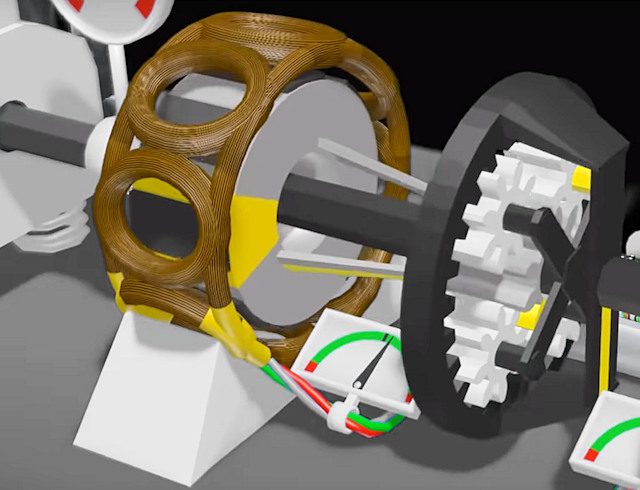
Here is the planetary gearbox in front, not in profile in the diagram above, we can better see the connections between the various gears associated with MG1, MG2 and ICE.
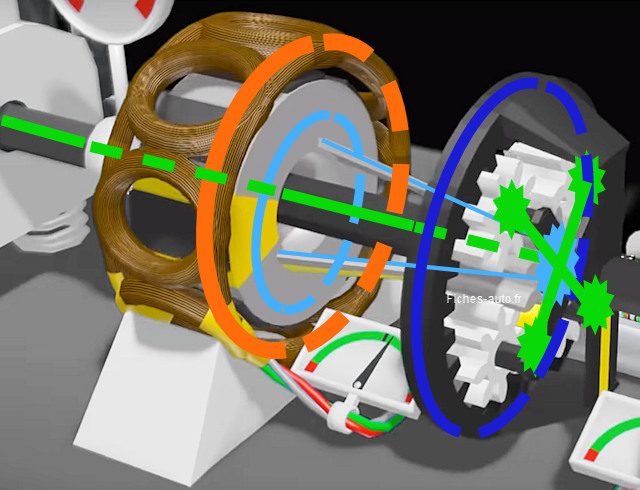
The difficulty lies in understanding the principle of the planetary train, knowing that the internal movements do not coincide depending on the modes of movement, but also on the speed ...
No clutch?
Unlike all other transmissions, the HSD does not need a clutch or torque converter (for example, a CVT needs a torque converter). This is where the electromagnetic force binds the wheels to the engine through the planetary train thanks to MG1. Then it is the rotor and stator of the latter (MG1) that then create the effect of friction: when you rotate the electric motor by hand, resistance arises, and it is the latter that we use here as a clutch.
It is even better when, during friction (the difference in speed between the stator and the rotor, therefore between the motor and the wheels), electricity is generated. And that electricity will be stored in the battery!
This is why the HSD system is considered very intelligent, because it provides a minimum of energy loss by recovering energy at the moment of friction. On the classic clutch, we lose this energy in heat, here it is converted into electricity, which we restore in the battery.
Thus, there is also no mechanical wear, since there is no physical contact between the rotor and the stator.
When stopped, the engine can run without stopping because the wheels do not block the engine (which would have happened if we had stopped on a manual transmission without shutting down). The blue sun gear (also called idle) is free, so it separates the motor wheels (hence the green crown planetary gears). On the other hand, if the sun gear begins to receive torque, it will connect the green gears to the crown, and then the wheels will begin to rotate gradually (electromagnetic friction).
If the sun gear is free, force cannot be transmitted to the crown.
As the rotor spins, friction is created in the stator, which causes torque, and this torque is transmitted to the sun gear, which locks up and even eventually rotates in the other direction. As a result, a connection is created between the motor shaft at the center and the ring gear at the periphery (gear = wheels). Note that the device also serves to stop and start: when you want to start, it is enough to briefly block the sun gear for the ICE heat engine to receive torque from MG2 connected to the driven wheel (this then starts it like a starter. Does. Classic).

So, to sum it up:
- When stationary, the engine can rotate because the link between the engine axle and the ring gear is not established: the sun gear is free (even if the Prius generally shuts down when stationary to save fuel)
- By increasing the engine speed, the rotor spins fast enough to generate an electromagnetic force, which then transmits torque to the sun gear: creating a connection between the motor axis and the ring gear.
- When the connection is made, the speeds of the motor axis and the ring wheel are equal
- When the speed of the wheels gets faster than the engine, the sun gear starts spinning in the other direction to change the gear ratio (after everything is locked, it starts to "roll" to further increase the speed of the system). Rather, it can be said that, by receiving torque, the sun gear not only connects the motor axles and the drive wheel, but also causes them to subsequently accelerate (it not only brakes "resist", but also causes them to rotate in the following way)
100% electric mode
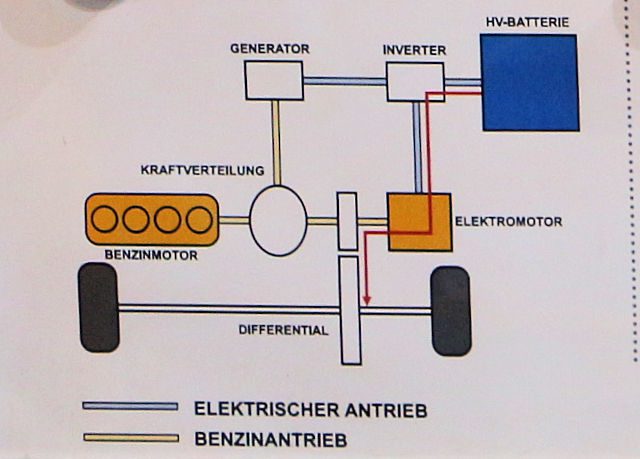
Here, the ICE (thermal) and MG1 motors do not play a special role, it is MG2 that rotates the wheels due to the electricity obtained from the battery (hence the energy arising from the chemistry). And even if MG2 turns MG1's rotor, it does not affect the ICE heat engine, and therefore there is no resistance that worries us.
Charge mode when stopped
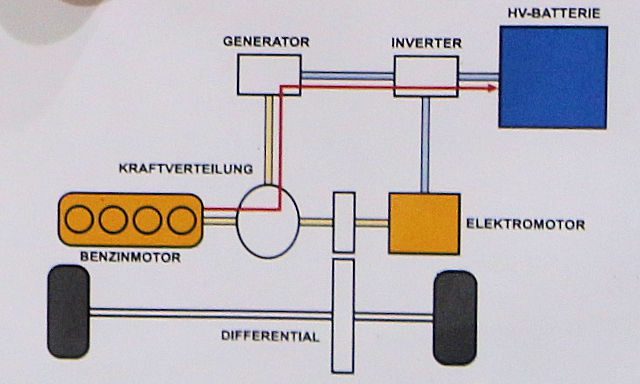
A heat engine is at work here, which rotates MG1 through a planetary train. In this way, electricity is generated and sent to the power distributor, which directs electricity only to the battery.
Energy recovery mode
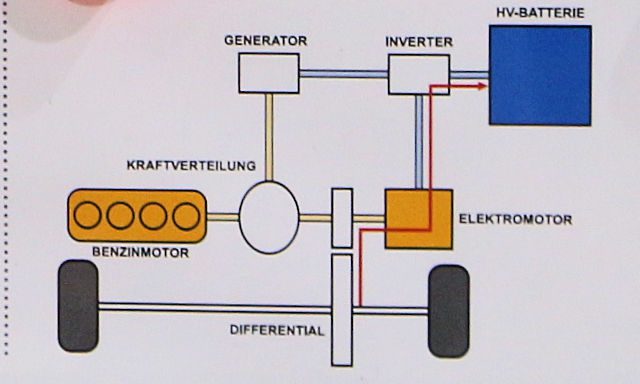
This is the famous "B" (regenerative braking) mode, which can be seen on the gear knob (when you push it, there is more engine braking associated with MG2 kinetic energy recuperation, the resistance is electromagnetic). The inertia / kinetic energy comes from the wheels and therefore propagates to MG2 through the mechanical gears and chain. Since the electric motor can be reversible, it will generate electric current: if I send juice to the electric motor, it will turn on, if I turn the stopped electric motor by hand, it will produce electricity.
This electrical current is recovered by the distributor to send it to the battery, which will then be recharged.
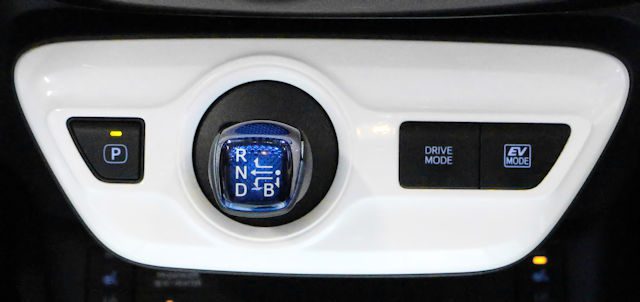
Electric and heat engine work together
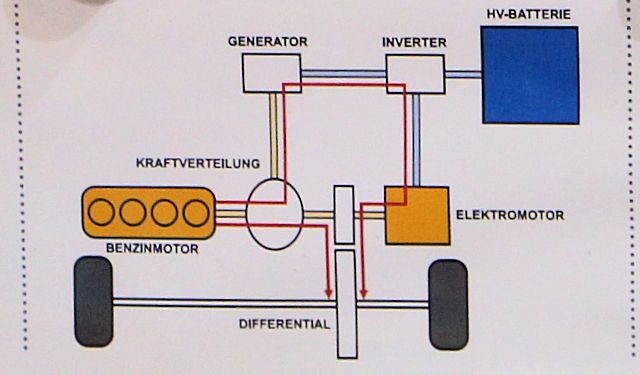
At a stable speed and at a good speed, that is, most of the time, the wheels will be driven by the power of the electric (MG2) and heat engines.
The ICE heat engine drives the planetary gear, which generates electricity in MG1. This will also transfer mechanical force to the wheels, since the planetary gear is also connected to them.
This is where difficulties can become limiting, because depending on the speed of rotation of the planetary gear will not be the same (in particular, the direction of certain gears).
A CVT-style gearbox (continuous and progressive change like on scooters) is created by the interaction of voltages between the motors (thanks to the magnetic effect caused by the juice passing through the coils: an induced electromagnetic field) as well as the planetary gear. which receives the power of multiple channels. Good luck to get this right at your fingertips, even if the video I put at your disposal will allow you to do so.
Maximum power
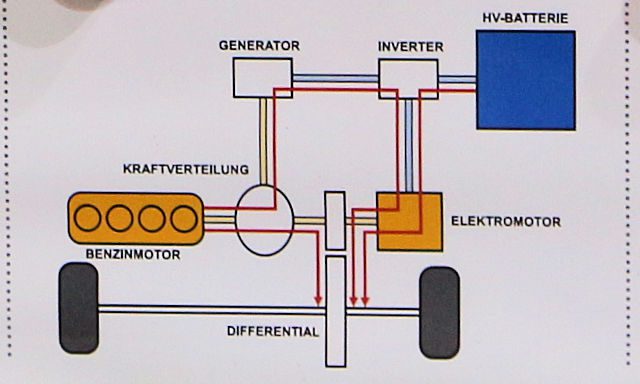
This is a bit like the previous paragraph, except that here we are also taking the electrical power the battery can supply, so MG2 benefits from this.
Here is the current version of the Prius 4:
Plug-in / rechargeable version?
The option with a rechargeable battery, allowing 50 km on an all-electric vehicle, consists only in installing a larger battery and installing a device that allows the battery to be connected to the sector.
You have to go through the power distributor and inverter first to manage the power difference and the different types of juice: AC, DC, etc.
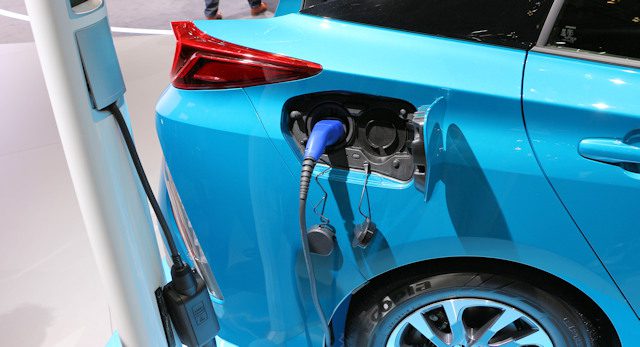
HSD 4X4 version?

As you should know, a 4X4 version exists on the Rav4 and NX 300H and is designed to be added to the rear axle, just like PSA's E-Tense and HYbrid / HYbrid4. Thus, it is a computer that ensures the constant power of the wheels of the front and rear axles, which, therefore, do not have a physical connection.
Why serial / parallel?
The device is called serial/parallel because it is called "series" when you are in 100% electrical mode. Therefore, we work in the same way as the BMW i3, the heat engine is a current generator that feeds the battery, which itself moves the car. In fact, with this method of operation, the engine is completely disconnected from the wheels.
It is also called parallel when the motor is connected to the wheels through a planetary device. And this is called batch build (see Various builds here).
Is Toyota doing too much with its system?

At the end of this article, I would like to say a little tirade. Indeed, Toyota talks a lot about its plug-in hybrid, and that's completely understandable and legal. However, it seems to me that in two respects the brand has gone too far. The first is to idealize technology, implying in passing that it will somehow save the planet, and that, in essence, the brand is initiating a revolution that will save us all. Sure, it cuts down on fuel consumption, but we also shouldn't be caricatured, a non-hybridized diesel minivan works pretty much the same, if not better, sometimes.
So Toyota is taking advantage of the current anti-diesel context to add a layer that I think is a little embellished here at the limit of handling, here is one:
TV commercial - Hybrid range - We choose Hybrid
Then there is a connection problem. The Japanese brand bases much of its communications on the fact that the car does not need to be charged from the mains, as if it were a technological advantage over the competition. This is actually a bit misleading as it is more of a disadvantage than anything else ... Hybrid cars that can be charged do not absolutely have to do so, this is an option that is offered in addition to its owner! So the brand manages to pass off one of the flaws as an advantage, and that's still strong, isn't it? Ironically, Toyota is selling plug-in versions of its Prius, and they should be better ... Here's one of the commercials:
Don't need to recharge it? Rather, I will say: "thin, there is no way to do ..."
Move on ?
To go further, I suggest that you carefully study this video, which, unfortunately, is only in English. The explanation is done in stages to make it as simple and straightforward as possible.
